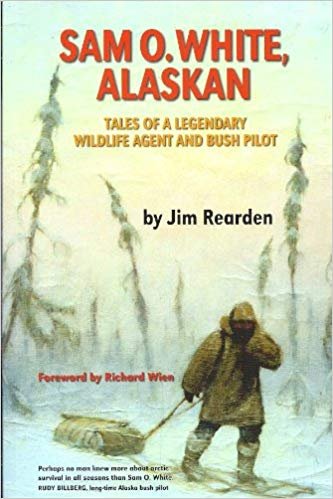This site is supported by you, the reader. If you make a purchase through one of my links, I may earn a small commission. Learn more here.
So many of us dream of going to Alaska, but only a few actually take the plunge. Sam O. White was one of those early adventuring pioneers who helped shape the great northern territory before it was even a state. Born in Eustis, Maine in 1891, the young woodsman longed for adventure after fighting overseas in World War I, and found a job that would take him to wild places. He signed up for the U.S. Coast and Geodetic Survey, working on ground truthing the early maps of Interior Alaska.
For several seasons, White travelled the Alaska backcountry, climbing peaks, running rivers, taking measurements and gathering knowledge. He spent winters trapping, hunting, and becoming part of the Alaska community, both in Fairbanks and in the bush.
When the survey job left Alaska, White was determined to stay. He applied for a job as a game warden with the newly formed Alaska Game Commission and was hired in 1927. This was before Alaska was a state, and the Game Commission, made up of local appointed commissioners and federal government agents, enacted the first game conservation laws in the territory. They hired wardens to enforce these laws, but before White’s time, regulations in such a wild place were a foreign concept to most.
Sam was stationed in Fort Yukon, a remote village on the Yukon River, and the epicenter of the country’s very lucrative fur trade. Furbearers were abundant here, and trappers were sprawled across the vast territory, each with their own traplines and cabins. They came to town once or twice a year to sell fur and resupply. These folks were rugged individualists. Most had come long distances to make their living here, and endured brutally tough conditions. Whether for the gold rush or fur boom, these folks had come to a place where there was virtually no law. They lived by their own code, and wildlife conservation was a foreign idea to most.
Sam White was a hard working, friendly, down to earth, no-nonsense kind of guy – the perfect type to lay down a new set of laws in such uncivilized country. He enforced trapping seasons to ensure furbearers were only taken when the fur was prime. He hauled trappers in for using poison, a common practice in some circles at the time. He stopped much of the killing of cow and calf moose, and ensured folks were purchasing the proper licenses.
Sam patrolled his territory by dog team and foot. These were the days before airplanes opened up the bush. He’d be days and weeks at a time on patrol, and lawbreakers could easily track his movements and stay ahead of the law. Sam figured there had to be a better way. At the time, pioneer aviator Noel Wien started making the first airplane flights in the Alaska bush, and established Wien Airlines, which would become a crucial air service in many remote Alaska villages. Sam befriended Noel and his brother Ralph, and they taught him to fly.
The Game Commission had no interest in buying Sam a plane or paying for the upkeep, so he did it himself. He bought a small plane and started patrolling his district by air. It’s probably safe to say that Sam O. White was the first game warden pilot in North America, and perhaps the world.
White found the airplane to be a complete game changer in his law enforcement work. What once took days or weeks now took hours. The area he could cover and things seen from the air would have required dozens of field wardens on the ground. He could sneak in on a game law violator at any time, without notice. This served to keep many trappers and hunters honest, not knowing when Sam might drop in on them.
Sam’s pioneering use of aircraft in his duties eventually led to the Game Commission establishing an aviation program, which proved critical to its success. He did a great deal to curb illegal activity and conserve game populations in those years. But times were changing in Alaska, and the political nature of the job finally got the best of Sam. When caught between compromising his integrity and keeping his job, he chose to leave.
The relationships he developed over the years served Sam well, and he was quickly hired on as chief pilot with Wien Airlines. He spent the rest of his career flying in and out of remote villages and far flung reaches of interior Alaska. Sam was the perfect fit for the job. He was a skilled and competent bush pilot, a thinker and problem solver, and a top notch people person. His relationships with trappers, traders and natives throughout the small villages made the job as enjoyable as any. And he saw quite a bit of adventure, too!
“Sam O. White, Alaskan” is nearly 400 pages of Sam’s writings about his life and career, along with historical research and context provided by Jim Rearden, who put it all together. It’s full of descriptions of the old timers of the Alaska bush and their rugged lifestyle, tales of close calls and survival, interesting wildlife cases, and hilarious stories. There’s also some pretty incredible historical perspective included as well. Sam White died in Fairbanks in 1976. He lived one heck of a life out there.
